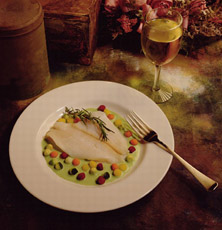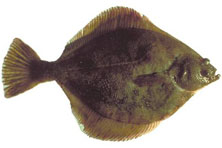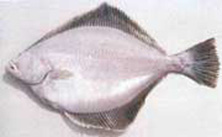Yellowfin Sole (Limanda aspera)
- Yellowfin sole has recovered from overfishing by foreign fleets in the 1960s and is now very abundant.
- The fishery for yellowfin sole is regulated by series of management measures developed by the North Pacific Fishery Management Council.
- Yellowfin sole is an excellent source of low-fat protein, calcium, and other important nutrients. For more on nutrition, see Nutrition Facts. (USDA)
- Yellowfin sole is the target of the largest flatfish fishery in the United States. The United States is responsible for the majority of the worldwide yellowfin sole catch.
|
 |
 |
 |
 |
| Nutrition Facts |
| Servings 1 |
| Serving Weight
100g |
 |
| Amount Per Serving |
 |
| Calories 91 |
 |
| Total Fat |
1.19 g |
 |
| Total Saturated Fatty Acids |
0.283 g |
 |
| Carbohydrate |
0 g |
| Sugars |
0 g |
| Total Dietary
Fiber |
0 g |
 |
| Cholesterol |
48 mg |
 |
| Selenium |
32.7 mcg |
 |
| Sodium |
81 mg |
 |
| Protein |
18.84 g |
 |
|
 |
 Offloading yellowfin sole from a commercial fishing vessel. Offloading yellowfin sole from a commercial fishing vessel.
|
 |
Did you know?
Yellowfin sole is one of the most abundant flatfish species in the eastern Bering Sea.
Yellowfin sole is the target of the largest flatfish fishery in the United States.
Most yellowfin do not feed in the winter; they begin to feed in the spring and during their migration to spawn.
|
|
| |
 |
|
Yellowfin sole are named for the yellowish color of all of their fins.
|
 |
|
While their eyed-side is olive to dark brown with dark mottling (as seen in the above photo), yellowfin sole have a pale underside.
|
|
Sustainability Status
Biomass: Biomass is the Bering Sea and Aleutian Islands area is well above the biomass needed to support maximum sustainable yield (BMSY), at 86% above BMSY.
Overfishing: No
Overfished: No
Fishing and habitat: Yellowfin sole are primarily caught with bottom trawl gear mainly over soft, sand bottoms. Because the species inhabiting soft bottom communities are frequently fast growing and short-lived, these communities may be more resilient to trawling impacts than other habitats. The Alaska Fisheries Science Center's Auke Bay Laboratory and Resource Assessment and Conservation Engineering Division are currently conducting studies on the effects of bottom trawling on habitat.
Bycatch: The main species caught as bycatch in the yellowfin sole fishery are Pacific halibut, Pacific cod, rock sole, flathead sole, pollock, Alaska plaice, arrowtooth flounder, snow crab, and red king crab.
Aquaculture: There is currently no commercial aquaculture of yellowfin sole in the United States.
|
Science and Management
The yellowfin sole fishery in the Bering Sea/Aleutian Islands (BSAI) area is regulated under the BSAI Groundfish Fishery Management Plan (FMP). The FMP controls the fishery through permits and limited entry, catch quotas, seasons, in-season adjustments, gear restrictions, closed waters, bycatch limits and rates, allocations, regulatory areas, record keeping and reporting requirements, and observer monitoring. Harvests are constrained by halibut bycatch limits, crab bycatch limits, and a 2 million metric ton cap. Since 2003, all yellowfin sole caught must be retained for processing.
Yellowfin sole is also included in the shallow-water flatfish complex in the Gulf of Alaska Groundfish FMP. They are only caught incidentally in this area, so management measures do not directly apply to this species.
|
Life History and Habitat
Life history, including information on the habitat, growth, feeding, and reproduction of a species, is important because it affects how a fishery is managed.
- Geographic range: Yellowfin sole can be found in North American waters off British Columbia, Canada, up to the Chukchi Sea (north of the Bering Sea). They are also found in the Sea of Japan along the Asian coast.
- Habitat: Yellowfin sole inhabit the eastern Bering Sea shelf. They live on the outer shelf in the winter and move to very shallow waters, less than 100 feet deep, to spawn and feed in the summer. Adults live on the ocean bottom over soft substrates mainly composed of sand.
- Life span: Yellowfin sole are relatively long-lived. Researchers have recorded females as old as 39 years.
- Food: Yellowfin sole are opportunistic feeders, preying on a wide range of species including clam siphons, worms, gammarid amphipods (small, shrimp-like crustaceans), krill, and fish.
- Growth rate: Slow.
- Maximum size: Up to 19 inches with an average of 13 inches.
- Reaches reproductive maturity: Most females reach maturity when they are 1 foot in length (at about 10.5 years old).
- Reproduction: Yellowfin sole have high reproductive potential and can produce 1 million to 3 million eggs.
- Spawning season: Spring and summer.
- Spawning grounds: Shallow waters on the inner shelf.
- Migrations: Adults migrate from winter grounds near the shelf margins to the inner shelf in April or early May to spawn and feed.
- Predators: Pacific cod and halibut prey on juvenile yellowfin sole.
- Commercial or recreational interest: Commercial
- Distinguishing characteristics: Yellowfin sole are a flatfish, with both eyes on one side of their body. Their eyed-side is olive to dark brown with dark mottling. Their dorsal and anal fins are yellowish on both sides of the body and have faint dark bars and a narrow dark line at their base. The body shape is generally round, with rounded edges on the tail fin. They have small mouths and moderately large eyes that are almost side-by-side, with the space between the eyes very narrow. The anal spine is thin, sharp, and exposed. Rough scales occur on both sides of the body.
|
Role in the Ecosystem
The diet of yellowfin sole varies by life stage. Larvae consume plankton and algae, early juveniles consume zooplankton, and late juvenile stages and adults' prey includes bivalves, polychaetes, amphipods, mollusks, euphausids, shrimps, brittle stars, sculpins and miscellaneous crustaceans. Juvenile yellowfin sole have been found during stomach content analysis of Pacific cod and Pacific halibut.
|
Additional Information
Market name: Sole or Flounder
|
Biomass
 Biomass refers to the amount of yellowfin sole in the ocean. Scientists cannot collect and weigh every single fish to determine biomass, so they use models to estimate it instead. These biomass estimates can help determine if a stock is being fished too heavily or if it may be able to tolerate more fishing pressure. Managers can then make appropriate changes in the regulations of the fishery. Biomass refers to the amount of yellowfin sole in the ocean. Scientists cannot collect and weigh every single fish to determine biomass, so they use models to estimate it instead. These biomass estimates can help determine if a stock is being fished too heavily or if it may be able to tolerate more fishing pressure. Managers can then make appropriate changes in the regulations of the fishery.
Biomass was at low levels during most of the 1960s and early 1970s due to high fishing rates. Biomass then increased because of light exploitation and above average recruitment and peaked in 1985. Since then, biomass slowly declined. In fact, over the past 20 years, biomass has declined 800,000 tons since the peak in 1985. In recent years, biomass has remained relatively high and stable.
Note: Biomass of yellowfin sole age 2 and older is shown in the graph.
Landings
 Landings refer to the amount of catch that is brought to land. Yellowfin sole were overexploited by foreign fisheries from 1959 to 1962, when catches averaged about 400,000 tons. Abundance of yellowfin sole declined, and annual catches decreased to about 100,000 tons through the late 1960s and to 50,000 tons by the 1970s. Abundance increased in the 1980s, resulting in increased catch by foreign and joint-venture operations. The fishery became fully domestic in 1990. Annual landings have averaged 106,000 tons since 1990. Landings are limited by red king crab and halibut bycatch limits. Landings refer to the amount of catch that is brought to land. Yellowfin sole were overexploited by foreign fisheries from 1959 to 1962, when catches averaged about 400,000 tons. Abundance of yellowfin sole declined, and annual catches decreased to about 100,000 tons through the late 1960s and to 50,000 tons by the 1970s. Abundance increased in the 1980s, resulting in increased catch by foreign and joint-venture operations. The fishery became fully domestic in 1990. Annual landings have averaged 106,000 tons since 1990. Landings are limited by red king crab and halibut bycatch limits.
Note: U.S. commercial landings are shown in the graph.
Biomass and Landings
 Are landings and biomass related? Landings are dependent on biomass, management measures in the fishery, and fishing effort. Are landings and biomass related? Landings are dependent on biomass, management measures in the fishery, and fishing effort.
Data sources:
Biomass and landings from 2008 BSAI Yellowfin Sole Stock Assessment
|
Important Dates
1954 – Yellowfin sole fishery begins on the Bering Sea shelf
1959-1962 – Yellowfin sole is overexploited by foreign fisheries; catches average 404,000 tons annually
1963-1971 – Catches decline to an annual average of 117,800 tons due to decreased abundance of yellowfin sole
1972-1977 – Catches further decline to annual average of 50,700 tons, partially due to the discontinuation of the U.S.S.R. fishery
Early 1980s – Stock condition improves; catches begin increasing
1980s – U.S. fisheries develop rapidly
1985 – Biomass peaks; catches peak at 227,000 tons
1990 – Harvesting and processing of yellowfin sole is exclusively domestic
1997 – Catch of 181,389 tons is largest since 1990
1998-2005 – Catch averages 78,000 tons
2008 – Highest annual catch in past 8 years, totaling 148,000 tons
|
Notes and Links
General Information:
Groundfish of the Bering Sea and Aleutian Islands Area - Species Profiles
Groundfish of the Gulf of Alaska: A Species Profile
Alaska Fisheries Science Center - Yellowfin Sole Research
Fishery Management:
FMP for Groundfish of the Bering Sea and Aleutian Islands and Appendix
Gulf of Alaska Groundfish Fishery Management Plan and Appendices
Stock Assessments:
2008 BSAI Yellowfin Sole Stock Assessment
|
| |
|



